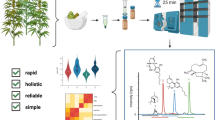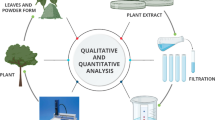Abstract
Traditional herbal medicines have been used for the treatment of various diseases and improving health for many years until the present time. The presence of phytochemical constituents of the herbal medicines has provided a significant contribution to modern therapeutics. Awareness of the chromatographic fingerprint is useful in the discovery of effective therapeutic agents. Among the commonly used traditional herbal medicines are the pteridophyte species. This includes Drynaria quercifolia, Diplazium esculentum, and Asplenium nidus that can be found in Bukidnon, Philippines. This paper describes the development of a high-performance thin-layer chromatography (HPTLC) method for the chromatographic fingerprints of the fern species. The presence and separation of phytoconstituents were evaluated using different mobile phases with varying polarities and proportions. The plates were derivatized using natural products (NP) reagent. The mobile phase composed of ethyl acetate‒formic acid‒acetic acid‒water (30:2.75:2.75:6.5, V/V) produced a good separation of the compounds present in the fern species. The developed HPTLC method for the fingerprint of the fern species was validated qualitatively by considering the RF values of the selected zones to evaluate the stability of the fingerprint. The validation results proved that the developed method is reproducible, precise, and robust. This method can thus be used for the chemical profiling and standardization of the fern species and the developed fern herbal products for quality monitoring.






Similar content being viewed by others
References
Rates SM (2001) Plants as source of drugs. Toxicon 39(5):603–613. https://doi.org/10.1016/S0041-0101(00)00154-9
Gupta P, Patil D, Patil A (2019) Qualitative HPTLC phytochemical profiling of Careya arborea Roxb. bark, leaves and seeds. 3Biotech 9(8):311. https://doi.org/10.1007/s13205-019-1846-x
Kharat S, Namdeo A, Mehta P (2017) Development and validation of HPTLC method for simultaneous estimation of curcumin and galangin in polyherbal capsule dosage form. J Taibah Univ Sci 11(5):775–781. https://doi.org/10.1016/j.jtusci.2016.10.004
Amoroso VB, Antesa DA, Buenavista DP, Coritico FP (2014) Antimicrobial, antipyretic, and anti-inflammatory activities of selected Philippine medicinal pteridophytes. Asian J Biodivers. https://doi.org/10.7828/ajob.v5i1.479
Mannan MM, Maridass M, Victor B (2008) A review on the potential uses of ferns. Ethnobot Leaf 12(1):281–285. https://opensiuc.lib.siu.edu/ebl/vol2008/iss1/33
Das HB, Majumdar K, Datta BK, Ray D (2009) Ethnobotanical uses of some plants by Tripuri and Reang tribes of Tripura. Nat Prod Rad 8(2):172
Mollik MAH (2010) The effect of medicinal plants on sexually transmitted infections and cancer: results from a cross-sectional study in Habiganj district of Bangladesh. Eur J Integr Med 2(4):220–221. https://doi.org/10.1016/j.eujim.2010.09.100
Pradhan S, Prakash Tamang J (2015) Ethnobiology of wild leafy vegetables of Sikkim. Indian. J Trad Knowl 14(2):290–297
Zannah F, Amin M, Suwono H (1844) Lukiati B (2017) Phytochemical screening of Diplazium esculentum as medicinal plant from Central Kalimantan, Indonesia. AIP Conf Proc 1:050001. https://doi.org/10.1063/1.4983439
Nandwani D, Calvo JA, Tenorio J, Calvo F, Manglona L (2008) Medicinal plants and traditional knowledge in the Northern Mariana Islands. J Appl Biosci 8(2):323–330. www.biosciences.elewa.org
Lai HY, Lim YY, Tan SP (2009) Antioxidative, tyrosinase inhibiting and antibacterial activities of leaf extracts from medicinal ferns. Biosci Biotechnol Biochem 73(6):1362–1366. https://doi.org/10.1271/bbb.90018
Kamboj A, Saluja AK (2017) Development of validated HPTLC method for quantification of stigmasterol from leaf and stem of Bryophyllum pinnatum. Arab J Chem 10:S2644–S2650. https://doi.org/10.1016/J.ARABJC.2013.10.006
Reich E, Schibli A, DeBatt A (2008) Validation of high-performance thin-layer chromatographic methods for the identification of botanicals in a cGMP environment. J AOAC Int 91(1):13–20. https://doi.org/10.1093/jaoac/91.1.13
Phaisan S, Yusakul G, Sakdamas A, Taluengjit N, Sakamoto S, Putalun W (2020) A green and effective method using oils to remove chlorophyll from Chromolaena odorata (L.) R.M. King & H. Rob. Songklanakarin J Sci Technol 42(5):1084–1090
United States Pharmacopeia (2015) General Chapter <203> High-performance thin-layer chromatography procedure for identification of articles of botanical origin. In: The United States pharmacopeial convention, 38-NF 33, First Supplement, Rockville, MD.
Do TKT, Schmid M, Phanse M, Charegaonkar A, Sprecher H, Obkircher M, Reich E (2021) Development of the first universal mixture for use in system suitability tests for high-performance thin layer chromatography. J Chromatogr A 1638:461830. https://doi.org/10.1016/j.chroma.2020.461830
Do TKT, Clark K, Christen P, Reich E (2020) Quality assessment of Sclerocarya birrea leaves and leaves products from Burkina Faso based on fingerprinting using HPTLC. JPC—J Planar Chromatogr-Mod TLC 33(5):439–448. https://doi.org/10.1007/s00764-020-00058-5
Reich E, Schibli A (2007) High-performance thin-layer chromatography for the analysis of medicinal plants. Thieme Medical Publishers, New York, NY. https://doi.org/10.1055/b-002-66241
Acknowledgements
The authors acknowledge the Department of Science and Technology, Philippine Council for Health Research and Development (DOST-PCHRD) for the study’s funding under the Central Mindanao University Tuklas Lunas Development Center (CMU-TLDC).
Funding
This study was supported by Philippine Council for Health Research and Development (Grant No. 416-190).
Author information
Authors and Affiliations
Corresponding author
Ethics declarations
Conflict of interest
No potential conflict of interest was reported by the authors.
Rights and permissions
Springer Nature or its licensor holds exclusive rights to this article under a publishing agreement with the author(s) or other rightsholder(s); author self-archiving of the accepted manuscript version of this article is solely governed by the terms of such publishing agreement and applicable law.
About this article
Cite this article
Enot, M.M., Sabesaje, R.D., Presores, G.M.S. et al. Development of an identification method for fern extracts using high-performance thin-layer chromatography (HPTLC). JPC-J Planar Chromat 35, 491–500 (2022). https://doi.org/10.1007/s00764-022-00204-1
Received:
Accepted:
Published:
Issue Date:
DOI: https://doi.org/10.1007/s00764-022-00204-1




